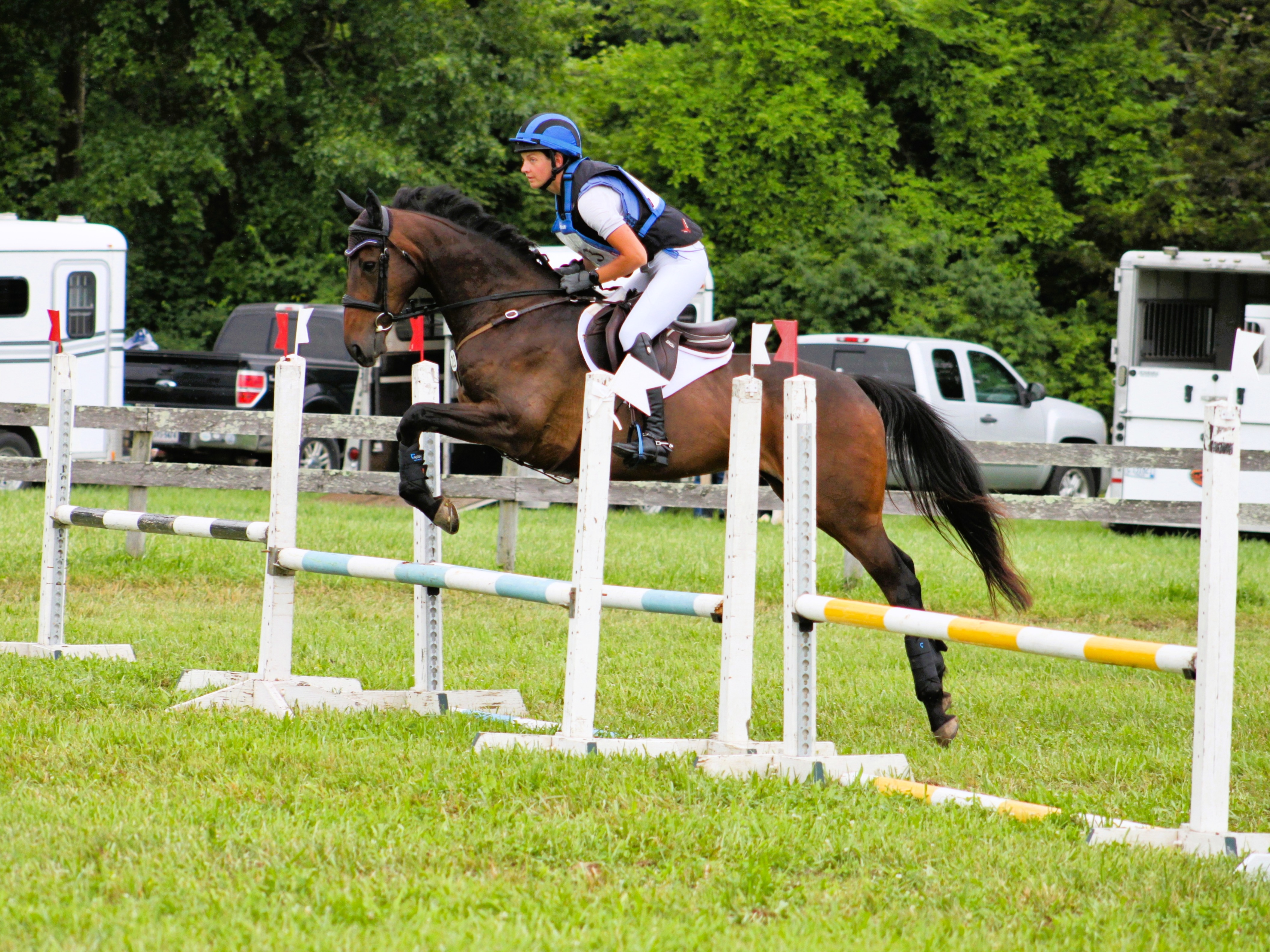This week, we’ll be bringing you a breakdown of each phase and its Olympic nuance with the help of several experts who were gracious enough to lend us some of their time and knowledge. Yesterday, we published a breakdown of the unique Olympic dressage test. Now, let’s continue with some context on Olympic cross country.
The cross country test at the Olympics shares many commonalities with its 4* and 5* counterparts around the world, but there are some key differences in designing an Olympic track to be sure.
What makes cross country in the Olympics unique?

Małgorzata Cybulska and Chenaro 2. Photo by Shannon Brinkman Photography.
The first element of uniqueness in the Olympics when we’re talking about cross country is the technical specifications.
The Olympics are, generally speaking, put onto pieces of land that are not ordinarily used for equestrian competition, or they are put on specifically-built venues that are new and have not been used for competition before. A recent example would be Sea Forest Island, the manmade island in Tokyo on which the cross country was built and has since been converted into public parkland. The most recent similar environment that comes to mind in direct comparison is London, during which cross country took place in Greenwich Park. This year, cross country will take place on the historic parklands of the Chateau de Versailles.

The reinforced mound that’ll afford further possibilities for interesting questions on cross-country.
For this reason, the maximum distance of the cross country is set out in the rules as 5800 meters. This is just a hair higher than the FEI 4* minimum distance of 5700 meters, making this course on the shorter side in terms of 4*-L-classified competitions, which the cross country at the Olympics is considered. The maximum amount of jumping efforts is 42, which is slightly higher than the 4* maximum of 40.
This ground is protected, which means there wasn’t much that could be done in terms of removing any of the existing horticulture or changing the makeup of the ground to, say, build up some terrain (though there was an artificial mound that was created to provide some change in terrain, as well as several crossings of the canal and other water questions). Much earlier on in the process, designer Pierre Le Goupil would have laid out the general track he would have wanted to use. Those areas were subsequently gated off to preserve and maintain the footing and keep it safe from the millions of visitors who frequent the Chateau and parklands each year. A layer of turf was also installed before any construction, including in the grandstand area, was begun, to ensure the protection of the grass underneath and to provide a level surface and avoid sloping ground.
Below is a very early map of the route that was planned, taken back in 2023 at the test event. The final route and course plan has yet to be revealed, but it should be set at about 5.3 km or a little over 3 miles.

The map of the cross-country track that’s been extensively prepped for 2024, with the chateau on the right-hand side and the back of house area on the left.
You can read much more on the work that’s gone into the creation of the equestrian venue and the cross country in our report from the 2023 “test event” here.
The unique challenge of designing at the Olympics

Andrew Hoy and Vassily de Lassos. Photo by Shannon Brinkman.
When you think about designing a cross country course on a venue that’s never had a course before, the challenge facing the designer becomes clear.
“The thing is that when you have an Olympic course, especially on a venue that has not been used, it’s like running a brand new event,” Derek di Grazia, who was the designer for the postponed 2020 Olympics in Tokyo, said. “You don’t know how a different piece of ground is going to ride. You have an idea, but you certainly don’t have full knowledge like you would if you’re designing at a venue like Kentucky or Badminton.”
Here, Derek references the importance of hosting a test event (Paris did not host a full test competition as is tradition, opting instead to send four riders to the venue in 2023 for a shortened test of the facilities) as a valuable information-gathering opportunity.
“It makes a huge difference to work the site so you understand where the deficiencies are and where the strong points are,” he said. “You can try to improve on those things in the time between the test and the Olympics. In Tokyo this was quite useful for me.”
“Flow” would perhaps be the word most riders or designers would toss out when asked to describe an ideal cross country course in one word. A course that allows horses to gain a rhythm and stay in it is invaluable (not to mention safer), but it’s not easy to do when you’re limited in space. Remember, even though this park isn’t small — it’s got about 2000 acres to call home — the usable space, with it being protected land, is much more limited.

Michael Jung and Chipmunk FRH. Photo by Shannon Brinkman.
“It’s apples and oranges,” Derek said when asked how a design here and its challenges would differ from another event. “When you go to a Burghley or a Kentucky or any sort of parkland course, it’s quite different than designing on these smaller venues. You’re always trying to create a course that flows and is at the level that you want, but the route to the end result is much different.”
Another aspect that must be considered is the competition you’re designing for. At the Olympics, we’ll see the cream of the crop from around the world, but as with any Olympic sport there will also always be competitors from countries that do not have the privilege of strong funding and opportunity for world-class preparation. This is true for any course, especially a championship: test the best, without punishing the rest.
So how does a designer balance the need to challenge the best in the world (while also not having the freedom to design to the most difficult technical specifications, such as 5*), while also ensuring that those who did not have as stiff of preparation can finish safely?
“Long routes are key,” Derek said. “Especially when I was in Tokyo, the whole thing was being worried about how the heat was going to affect the horses. We knew it was going to have some effect and it certainly proved to, and so I think the one big thing was the long routes. We were really concerned about trying to make sure we kept the horses going and weren’t making them go in circles to eat up time. In fact, you’re designing a whole course within a course when you really start to think about it. You’re always designing what we call the straight way, at a real championship four-star level, and then you have your alternate routes where you need them. That’s the way I went about it.”
Of course, Pierre Le Goupil will have his own stamp and style and way of thinking about his designs. North American readers will likely have seen clips or watched footage from the 2023 Pan American Games in Chile, which was designed by Pierre. He also designed at the most recent European Championships last year at Haras du Pin. Team USA did send a small contingent of observers to this event to research Pierre’s design.
You can watch reigning European Champion Ros Canter and Lordships Grafflo around the Haras du Pin track below:
How riders and horses will stand out
One of the influential factors on cross country day can be the team’s draw and subsequent order of running. In a team competition, the placement of each rider’s round can be invaluable. Generally the final rider a team sends out will be the most experienced, but it remains a Chef d’Equipe and team decision to sort out what will be the best strategy.
We can also anticipate the optimum time to play a strong role, especially given the expected twisting nature of the cross country. While dimensionally not as imposing as a 5* event, this track will be mentally and technically challenging in particular and will task riders with managing speed where they can and accuracy everywhere. As with any course, a rideable horse will be faster and more competitive than a strong horse that requires much communication.

Crossings like this will feature for both spectators and horses.
We expect hot, humid conditions to be sure, but not quite to the excess that we saw in Tokyo. Fitness will of course play a large role, but the flatter topography and meticulously-maintained footing of this year’s Olympic course should not make this as grueling of a fitness challenge as some championships before.
Coming next, we’ll dive into the details of the two show jumping rounds that are unique to Olympic competition. Stay tuned and Go Eventing.
#Paris2024: [Website] [Equestrian Schedule, Timing, Scoring] [Peacock for U.S. Viewers] [How to Watch Guide] [Ticket Resale Market] [Spectator Guides] [EN’s Coverage]






















